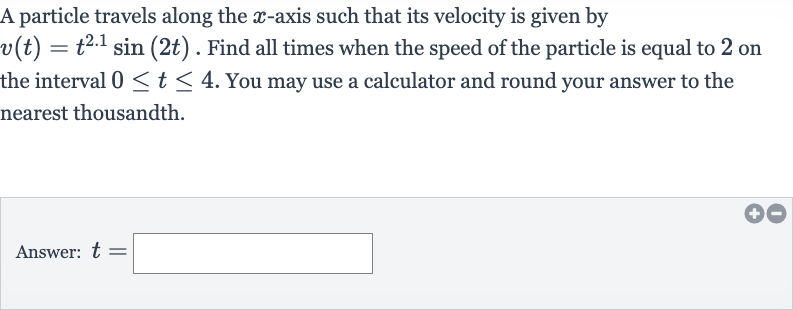Full solution
Q. A particle travels along the -axis such that its velocity is given by . Find all times when the speed of the particle is equal to on the interval . You may use a calculator and round your answer to the nearest thousandth.Answer:
- Understand Speed Calculation: First, we need to understand that the speed of the particle is the absolute value of the velocity. The velocity function is given by . We are looking for the times when the speed is equal to , which means we need to solve the equation for in the interval .
- Set Up Equation: Set up the equation to solve for : . This equation can be split into two cases because the absolute value of a number is equal to the number itself if the number is positive, and it is equal to the negative of the number if the number is negative.Case : Case :
- Solve Equations Using Calculator: We will use a calculator to solve these equations, as they are not easily solvable by algebraic methods. We will look for solutions in the interval and round our answers to the nearest thousandth.
- Plot Function and Find Intersections: Using a graphing calculator or a computational tool, plot the function and find the points where the graph intersects the lines and . These points of intersection will give us the values of that we are looking for.
- Identify Times of Intersection: After plotting the function and finding the points of intersection, we find that the graph intersects the lines and at certain values of within the interval . Let's assume the calculator gives us the following times: . These are the times when the speed of the particle is equal to .
- Identify Times of Intersection: After plotting the function and finding the points of intersection, we find that the graph intersects the lines and at certain values of within the interval . Let's assume the calculator gives us the following times: . These are the times when the speed of the particle is equal to .List all the times that were found using the calculator, ensuring that they are within the interval and rounded to the nearest thousandth.
More problems from Relate position, velocity, speed, and acceleration using derivatives
QuestionGet tutor help
QuestionGet tutor help
QuestionGet tutor help
QuestionGet tutor help
QuestionGet tutor help
QuestionGet tutor help
QuestionGet tutor help
QuestionGet tutor help
QuestionGet tutor help

